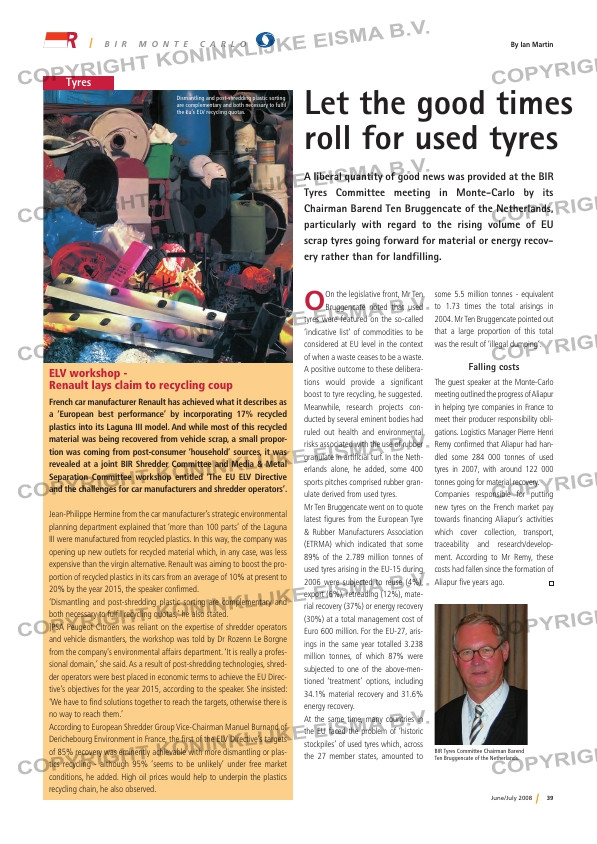Page 39 from: June / July 2008

39June/July 2008
B I R M O N T E C A R L O By Ian Martin
Tyres
O On the legislative front, Mr Ten Bruggencate noted that used
tyres were featured on the so-called
‘indicative list’ of commodities to be
considered at EU level in the context
of when a waste ceases to be a waste.
A positive outcome to these delibera-
tions would provide a significant
boost to tyre recycling, he suggested.
Meanwhile, research projects con-
ducted by several eminent bodies had
ruled out health and environmental
risks associated with the use of rubber
granulate in artificial turf. In the Neth-
erlands alone, he added, some 400
sports pitches comprised rubber gran-
ulate derived from used tyres.
Mr Ten Bruggencate went on to quote
latest figures from the European Tyre
& Rubber Manufacturers Association
(ETRMA) which indicated that some
89% of the 2.789 million tonnes of
used tyres arising in the EU-15 during
2006 were subjected to reuse (4%),
export (6%), retreading (12%), mate-
rial recovery (37%) or energy recovery
(30%) at a total management cost of
Euro 600 million. For the EU-27, aris-
ings in the same year totalled 3.238
million tonnes, of which 87% were
subjected to one of the above-men-
tioned ‘treatment’ options, including
34.1% material recovery and 31.6%
energy recovery.
At the same time, many countries in
the EU faced the problem of ‘historic
stockpiles’ of used tyres which, across
the 27 member states, amounted to
some 5.5 million tonnes – equivalent
to 1.73 times the total arisings in
2004. Mr Ten Bruggencate pointed out
that a large proportion of this total
was the result of ‘illegal dumping’.
Falling costs
The guest speaker at the Monte-Carlo
meeting outlined the progress of Aliapur
in helping tyre companies in France to
meet their producer responsibility obli-
gations. Logistics Manager Pierre Henri
Remy confirmed that Aliapur had han-
dled some 284 000 tonnes of used
tyres in 2007, with around 122 000
tonnes going for material recovery.
Companies responsible for putting
new tyres on the French market pay
towards financing Aliapur’s activities
which cover collection, transport,
traceability and research/develop-
ment. According to Mr Remy, these
costs had fallen since the formation of
Aliapur five years ago.
ELV workshop –
Renault lays claim to recycling coup
French car manufacturer Renault has achieved what it describes as
a ‘European best performance’ by incorporating 17% recycled
plastics into its Laguna III model. And while most of this recycled
material was being recovered from vehicle scrap, a small propor-
tion was coming from post-consumer ‘household’ sources, it was
revealed at a joint BIR Shredder Committee and Media & Metal
Separation Committee workshop entitled ‘The EU ELV Directive
and the challenges for car manufacturers and shredder operators’.
Jean-Philippe Hermine from the car manufacturer’s strategic environmental
planning department explained that ‘more than 100 parts’ of the Laguna
III were manufactured from recycled plastics. In this way, the company was
opening up new outlets for recycled material which, in any case, was less
expensive than the virgin alternative. Renault was aiming to boost the pro-
portion of recycled plastics in its cars from an average of 10% at present to
20% by the year 2015, the speaker confirmed.
‘Dismantling and post-shredding plastic sorting are complementary and
both necessary to fulfil recycling quotas,’ he also stated.
]PSA Peugeot Citroen was reliant on the expertise of shredder operators
and vehicle dismantlers, the workshop was told by Dr Rozenn Le Borgne
from the company’s environmental affairs department. ‘It is really a profes-
sional domain,’ she said. As a result of post-shredding technologies, shred-
der operators were best placed in economic terms to achieve the EU Direc-
tive’s objectives for the year 2015, according to the speaker. She insisted:
‘We have to find solutions together to reach the targets, otherwise there is
no way to reach them.’
According to European Shredder Group Vice-Chairman Manuel Burnand of
Derichebourg Environment in France, the first of the ELV Directive’s targets
of 85% recovery was eminently achievable with more dismantling or plas-
tics recycling – although 95% ‘seems to be unlikely’ under free market
conditions, he added. High oil prices would help to underpin the plastics
recycling chain, he also observed.
Dismantling and post-shredding plastic sorting
are complementary and both necessary to fulfil
the Eu’s ELV recycling quotas.
BIR Tyres Committee Chairman Barend
Ten Bruggencate of the Netherlands.
A liberal quantity of good news was provided at the BIR
Tyres Committee meeting in Monte-Carlo by its
Chairman Barend Ten Bruggencate of the Netherlands,
particularly with regard to the rising volume of EU
scrap tyres going forward for material or energy recov-
ery rather than for landfilling.
Let the good times
roll for used tyres
RI_019 BIR Tyres.indd 39 19-06-2008 11:19:07



